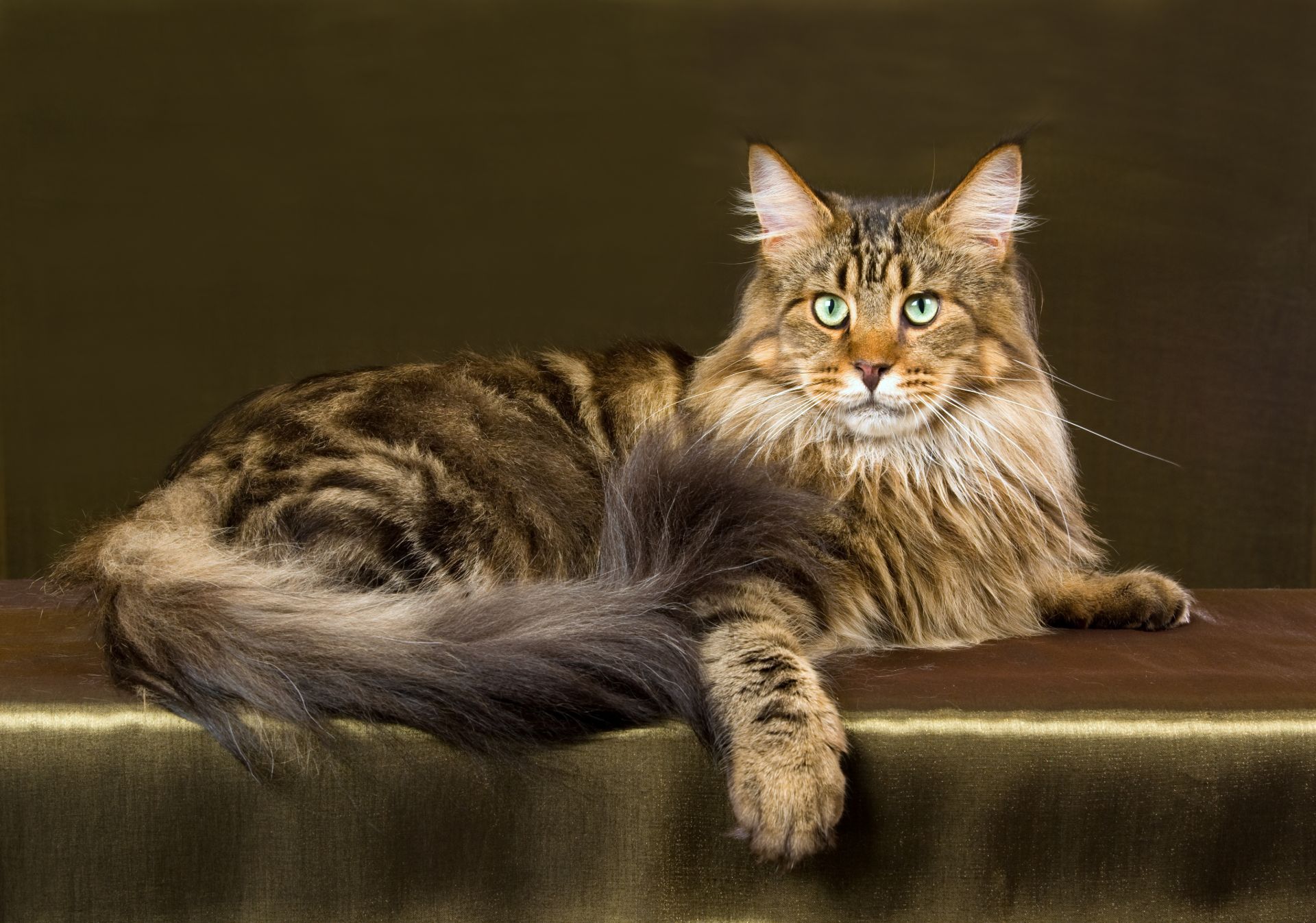Maine Coon cats arrived in the UK in the 1980’s and continue to grow in popularity. They are the biggest domestic cat breed measuring about a metre in length and can weigh up to 12 kilograms. They have long bushy tails and their origins are unknown, but it’s thought ship's cats bred with small native American cats and selective breeding has resulted in the glorious Maine Coon.
They are designed for bad weather and a cold climate with thick, long, virtually waterproof coats and large tufted paws useful for walking through snow in their native Maine, USA.
They have a characteristic ruff or bib of longer fur extending from the ears under the chin, lynx like ears with tufts of fur on the ends and come in a variety of beautiful colours and coat patterns, but a tabby pattern is the most common. They’re very friendly and talkative, making a whole range of chirrups and trills. They have lovely, happy personalities and are not aggressive at all, being known as one of the most gentle and friendly cat breeds capable of getting on with other cats and dogs quite happily.
Pet profile
A friendly, gentle, giant cat breed that’s talkative, made for bad weather and is easy to spot!
- Size: Large 25 – 40 cm tall (10-16 inches at the shoulder), around a metre in length
- Weight: 5-11 KG (11 – 24 Ibs in the biggest male cats)
- Life expectancy: 10 -12.5 years or longer
Exercise and nutrition
This generally healthy and hardy breed of cat needs a good quality diet and like any other cat, benefits from maintaining a healthy weight. Obesity can exacerbate problems such as hip dysplasia so guidance from your vet will help you to keep your Maine Coon at a healthy weight as they grow and mature. They take up to 4-5 years to reach maturity and benefit from a high protein diet, with very low carbohydrates. For this reason a grain free diet is good for them as they are, like all cats, obligate carnivores.
They are highly intelligent, love games and toys, which help to keep them active and healthy, and can be trained to do tricks and fetch. They have dog-like characteristics and can be trained to walk on a lead with a harness, like a dog!
Common health problems and illnesses
It’s always a good idea to buy a pure breed cat from a reputable breeder. The breed does have characteristic health issues to watch out for so ask to see your breeders genetic screening and x ray results for their breeding animals.
To ensure you can afford to buy the vet care they need if they have an accident or develop any health issues, take out cat insurance while your kitten is young, before they develop any problems that could be considered pre-existing conditions.
Hypertrophic cardiomyopathy is the most common form of heart disease in cats, causing thickening of the muscular walls of the heart. An echocardiogram can confirm the condition. All breeding cats should be screened for this illness and removed from breeding programmes if they have it. It’s probably best not to buy a kitten from a breeder that hasn’t screened their cats for this condition.
Cats with this condition might appear lethargic, have rapid or laboured breathing and once the condition has progressed, may collapse. If your cat seems to be struggling for breath and less energetic than usual please get them checked over by your vet and if diagnosed, there are treatments that can help.
Breeding cats can have their hips x-rayed to check that the development of their hips is normal, and as before, ask to see your breeder’s cats hip health reports before buying a kitten.
Hip Dysplasia is an hereditary deformity of the hip joints. It can be mild causing few problems or severe causing lameness and pain. A cat with the condition may move slowly or avoid jumping. Keeping your cat to a good healthy weight can help reduce symptoms and medication or surgery can help the condition in more severe cases.
If you think your cat has an issue with his hips take him to your vet to get a diagnosis and treatment plan.
This is a condition that is caused by the death of spinal cord neurons that activate skeletal muscles in the trunk and back legs. Cats with this condition typically walk with swaying rear ends and can have difficulty jumping. The condition doesn’t cause pain and doesn’t affect any other areas of a cat’s life but they might be safer living indoors. A DNA test can diagnose this condition in breeding cats and kittens.
Fun facts
- The record for the longest cat is held by a UK Maine Coon called Ludo measuring over 118 centimetres long. However, he’s almost 5cm shorter than the longest cat ever, also a Maine Coon, called Stewie, who was 123cm long.
- The cat in the Harry Potter movies, Mrs Norris, was played by 3 different Maine Coon cats.
- Maine Coon cats are the only show cat breed originating in US.
- A tabby Maine Coon called Cosey was the winner of the first American Cat Show held in New York City in 1895.

